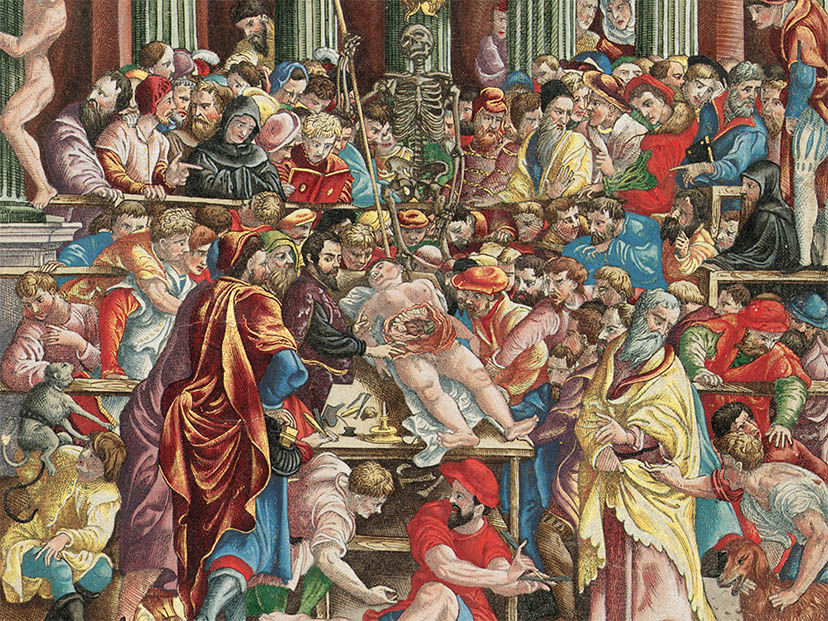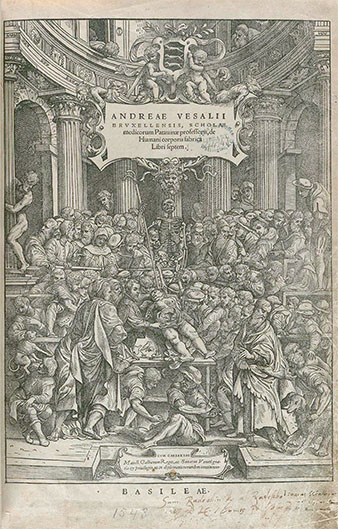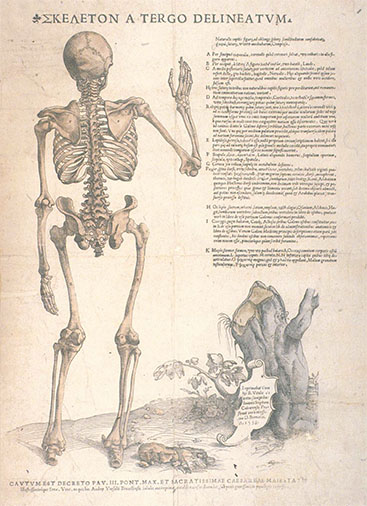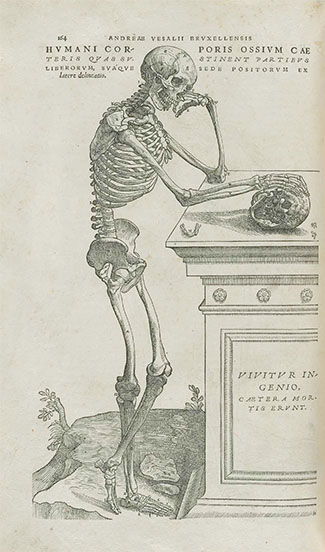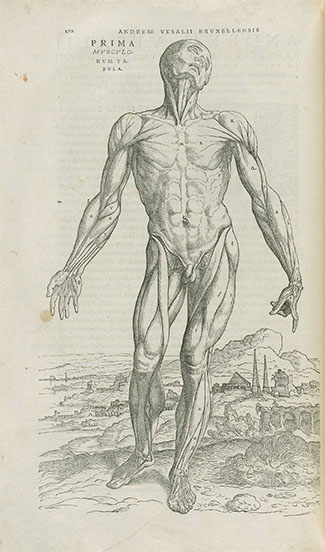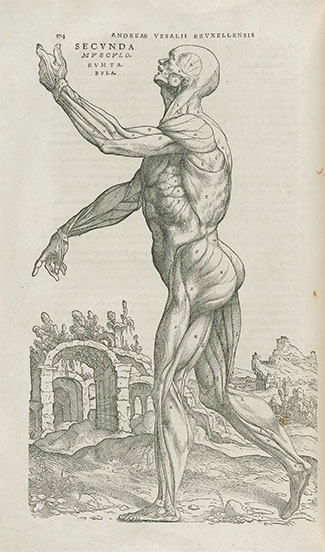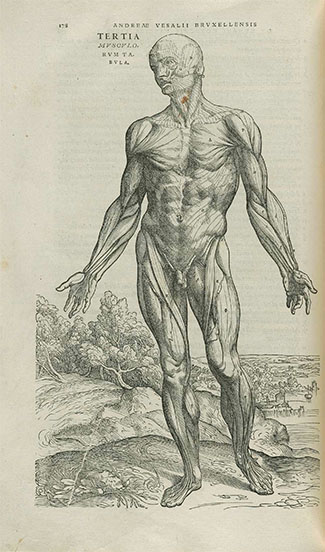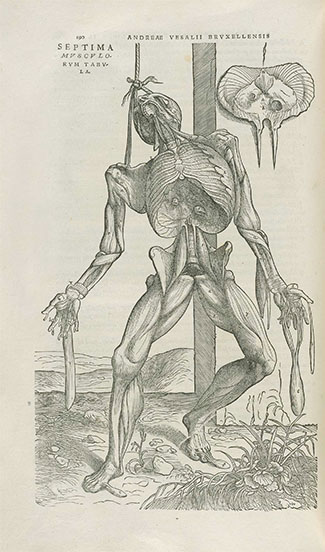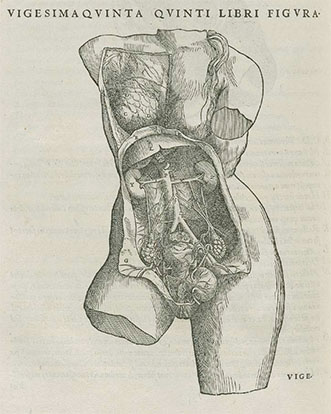45
De Humani Corporis Fabrica
Andreas Vesalius
Above is detail from the frontispiece to Andreas Vesalius’ De humani corporis fabrica.1 The elaborate woodcut shows a bearded Vesalius publicly dissecting a female corpse amidst more than 70 spectators, many of which were likely significant (although any specifics are now lost to the mists of time). The scene metaphorically compares anatomical structure to architectural design and the animals in the foreground suggest comparative anatomy. Finally, and notably, the scene omits the ancient symbols of medicine, perhaps suggesting the progressive nature of the work.
De Fabrica, published in 1543 when Vesalius was only 28 years old, is not only the most influential book in the history of medicine, but can legitimately lay claim to being one of the most important books ever published. Not only did it overturn 14 centuries of accepted Galenic tradition, but it was perhaps the first mechanically printed book to completely integrate every aspect of book design: content, art, layout and typography. A spectacular collaboration among the author, artist and publisher.
De Fabrica, frontispiece
Andreas Vesalius (Andreas van Wesel) was born into a wealthy and well-connected family of physicians in Brussels on 31 Dec 1514. He began his education at the Pedagogium Castrensis (Leuven), later enrolled in the Université de Paris, then was back in Leuven, and finally completed his doctorate in 1537 at the Universitas aristarum (Padua). After graduation he was offered the post of explicator chirurgiae.2
Here in Padua he began teaching, not by simply lecturing, but by personal demonstration. As one student noted “[he] was lecturer, demonstrator and dissector in one.” He began to prepare drawings for his students “as aids to strengthening memory” which culminated in 1838 in the publication of Tabulae anatomicae sex:3
Tabulae anatomica, plate vi, drawn by Calcar
The Tabulae were exactly what the name implied; six highly annotated anatomical tables drawn by Vesalius and Jan Steven van Calcar, a student in Titian’s Venitian workshop. The book, which was printed by B. Vitale in Venice and financed by Calcar, proved to be very successful. So successful, in fact, that it was soon widely plagiarized. The Tabulae, however, was just a warmup.
Around 1540, while still teaching, he began work on De Fabrica, or what he called his “big book.” The text was probably completed by Aug 1542 and the wood blocks by the end of the year. Vesalius took leave of his post and travelled to his printer, Johannes Oporinus in Basel, to oversee production. Oporinus, using two crews of compositors, took almost six months to lay out and print the book. The result, published in Aug 1543, was actually three books: De humani corporis fabrica libri septem (On the Fabric of the Human body in Seven Volumes),4 a shortened version for students, De humani corporis fabrica librorum epitome, and a German translation of Epitome, Von des menschen Cörpers Anatomey.
The text, more than 80,000 words, written in a complex and literary humanist Latin, was highly critical of Galen (and anyone else he didn’t like) and argued for a systematic and meticulous description based on direct observation.5 De Fabrica was the first book to describe, among other things, the mediastinum, the pleura, the pylorus, the ductus venosus and the azygos vein. Ultimately, however, the book would be known not for its text, but for its illustrations.
De Fabrica, page 164. The inscription on the pedestal reads “Genius lives on, all else is mortal”
The engraved woodblock plates were prepared in Padua, or maybe Venice, by an unknown artist at Vesalius’ expense.6 His OCD-level attention to detail and his uncompromising standards in their printing are what made De Fabrica so revolutionary. Although obviously intended to be didactic, the illustrations are wonderfully artistic, a fact mentioned by Vesalius in his printers note to the 1543 edition: “...they are not just simple outlines drawn in the common schoolbook manner; the artistic style ... is nowhere neglected.” It is clear that Vesalius intended De Fabrica to be for artists and the wealthy elite as much as for physicians.
Here, as an example, are several of the plates illustrating Vesalius’s muscle dissections – the so-called “muscle-men:”
De Fabrica, primary muscle dissection, page 170
De Fabrica, secondary muscle dissection, page 174
De Fabrica, tertiary muscle dissection, page 178
De Fabrica, seventh muscle dissection, page 190
Vesalius had the audacity to dedicate De Fabrica to Charles V, ruler of the Holy Roman Empire, and presented him with a hand-colored copy (see above) in the Autumn of 1543.6 This brazen flattery from an impetuous youth worked: Charles V was so impressed that he named Vesalius a court physician. For the next 20 years Vesalius would serve the courts of Charles V and his son Philip II, act as surgeon to European nobility, and continue to dissect and publish, including a major revision of De Fabrica in 1555.
In 1564, while returning home from a pilgrimage to the Holy Lands, his ship was cast adrift and Vesalius became seriously ill. Vesalius died almost immediately after the ship landed on the Greek island of Zakynthos on 15 Oct 1564.
De Fabrica, female urogenital dissection, page 478
1. This presentation copy for Charles V is the only one known to have been hand colored under the direction of Vesalius. It is, by way of an anonymous donor, now in the New York Public Library. This image is from their Seeing is Believing exhibition.
2. There is so much published work on Vesalius that it is somewhat difficult to know where to start. The classic bibliography is: Cushing, Harvey. A Bio-bibliography of Andreas Vesalius. Hamden, Conn.: Archon Books, 1962. An updated version of Cushing, Vesaliana: an updated bibliography of Andreas Vesalius, is available online at Maurits Biesbrouck's andreasvesalius.be. Vivian Nutter, the distinguished medical historian, provides perhaps the best online biography at Northwestern University’s Vesalius Project.
There is also no shortage of De Fabrica images on the internet. The images above are from the NIM’s Historical Anatomies on the Web, an excellent site that I shall crib heavily from in future posts. A complete copy of the book, including high-res images, is available online from the the History of Science Collections, University of Oklahoma Libraries.
3. There are only two extant copies of the Tabulae known. One is in the Special Collections of the Glasgow University Library, and is online, and the other is in Bibliotheca Nazionale Marciana, and is not online. The image presented here comes from Glasgow, obviously.
4. De humani corporis fabrica libri septem was published as a deluxe folio. The book consisted of 663 17 5/8" × 11 3/8" pages and 83 plates containing 430 illustrations. The book was rather expensive and intended for a privileged audience. Oporinus listed it and the Epitomie together for five florins and three batzen in 1547: probably more expensive at the time then one of those ridiculously oversized Taschen titles are today.
5. This, not surprisingly, created quite a few enemies. As Jacob Sylvius, Vesalius' former teacher, wrote in an open letter to Charles V: “I implore his Imperial Majesty to punish severely, as he deserves, this monster born and bred in his own house, this worst example of ignorance, ingratitude, arrogance, and impiety, to suppress him so that he may not poison the rest of Europe with his pestilential breath.” Tweet that.
6. Exactly who did the unsigned woodblock illustrations (cut parallel to the grain in pear wood) in unclear. For years they were attributed to Jan Steven van Calcar, or, occasionally to Titian himself, although this now seems unlikely. Current scholars attribute them simply to an artist (or, more likely, artists) from Titians workshop. The woodblocks floated around Europe for the next 400 years and most of them ended up in the Bayerische Staatsbibliothek, where they were last used to print Andreae Vesalii Bruzellensis icones anatomicae, ediderunt Academia Medicinae Nova-Eboracensis et Bibliotheca Universitatis Monacensis. (New York and Munich: Bremer Press, 1934). They were ultimately destroyed by Allied bombing around 1944.
16 Nov 2009 ‧ Anatomicae
